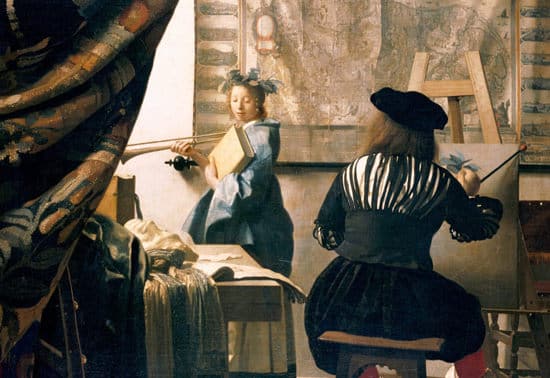
The Art of Painting (detail), Johannes Vermeer, 1666
You might think you need more time, or the perfect paint brand or a new brush.
When the weekend comes and you’ve finally managed to find some ‘you’ time, the blank canvas stares back at you and the finished portrait, you so desperately wanted to achieve, seems a world away.
Your motivation is high, your drawing’s good but the jump from pencil to paint has hit a wall.
Flicking through an art magazine or shopping for a new paint colour suddenly seems like an attractive idea.
You’ll start next week when you’ve got the exact colour you need.
But what if these actions are holding you back?
What if you forced yourself to try and achieve more with less, give yourself some constraints and your portrait painting could make giant leaps forward?…
1. The Art of the Start
One of the biggest regrets you can have in any creative endeavour is not starting.
It can eat you up and days, months and years can pass by before you give yourself time, and permission to start.
Lack of time can seem like the perfect excuse, kids, work commitments…life.
But giving yourself permission can be the real truth.
Permission to start.
Permission to fail.
Permission to call yourself an artist.
2. Having a method
I always wanted to paint portraits but I put it off, I was worried about how they would turn out, and compared to the Old Masters I’d admired so much, it seemed like an overwhelming challenge.
Would everyone laugh when they didn’t look like the sitter?
So I continued painting abstracts professionally, they were selling well and it was what I was known for.
But the portrait bug was just buried deeper, it was the biggest mistake I made.
Then one evening me and Vanessa went to dinner at a friends house, both fellow artists.
After dessert, Warren excitedly showed us a wedding present they’d been waiting for 10 years. It was a life-size, double portrait a friend of theirs had painted, but in classic bohemian style, the artist only owned a motorbike and had never made it up the M6 to deliver it.
It was so impressive that a real, alive, ordinary person had created this work on such a grand scale and it had such an emotional impact on our friends, it couldn’t fail to inspire me.
The very next day I went to my studio and Vanessa became my first unwilling sitter for a full technicolor portrait, my approach was, to say the least, erratic!
The error of my ways
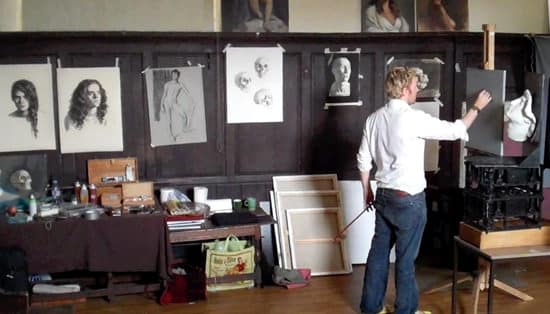
Studying sight size portraiture at The Sarum Studio with Nick Beer
From a list of paint colours from one book to a brush recommendation from another tutor and never mind the many hours spent in museums studying the paintings first hand.
I developed my own style… but they took hours and hours and the process was painful, the results…. just o.k.
So I then took a new creative approach, 20 colours, blaring Classical music and a livener of whiskey, inspiration should take over… well it sort of did.
I did produce a lot of portraits, some Award-winning, so not too shoddy – but something was still missing.
The subtleties of tone and smokiness of the Old Masters kept alluding me, so I decided to go to the source and head for Florence, Italy.
It was here I had a breakthrough, courtesy of Maestro, Micheal John Angel founder of the Angel Academy of Art, Florence. I’d been lucky enough to win a Queen Elizabeth Craft Scholarship to study there and also sight-size portraiture at The Sarum Studio, Salisbury with Nick Beer (senior instructor at the Charles Cecil Studio, Florence)
It was on this journey that I learnt the error of my ways.
The complicated recipe I’d created for myself was all wrong, I’d been using too many colours and working too hard.
How come no-one had told me this before? I’d wasted so much time and energy.
This was the inspiration to create this resource, to help other aspiring artists to not make the same mistakes I did.
Creative constraints
American realist painter Chuck Close wanted to challenge himself in his early painting career, so in the early 1960’s he made a choice.
He decided to start a new epic series of paintings (some were nearly 9ft-high) with one key ingredient missing….he threw away his paintbrushes.
This forced him to work within the boundaries of creating a painted image without using the one seemingly essential tool of the trade.
But his results were astounding.

“Frank”, Chuck Close, 1969, Acrylic on canvas.
He developed a technique akin to that of printmakers, using a 3 colour range to build up his paintings and used an airbrush rather than a paintbrush.
He broke down the process and tackled the subject with a methodical approach.
“If you’re overwhelmed by the whole, break it down to pieces.”
Chuck Close
However, this self-inflicted constraint wasn’t the only obstacle he faced in his painting career. During the mid-eighties, at the height of his success, he suffered from an illness which left him confined to a wheelchair.
Did this stop his productivity?
No, he learned to adapt. He went back to the paintbrush, this time having it strapped to his hand.
Instead of working on a smaller, more manageable scale he installed a forklift to raise and lower him. With each painting taking between four months to a year to complete, every day he had to show up and paint.
“The advice I like to give young artists, or really anybody who’ll listen to me, is not to wait around for inspiration. Inspiration is for amateurs; the rest of us just show up and get to work….You feel like you need this great idea before you can get down to work, and I find that’s almost never the case.”
Chuck Close
Creative constraints can give you focus in your paintings.
Mastering Black & White Portraiture with Oils
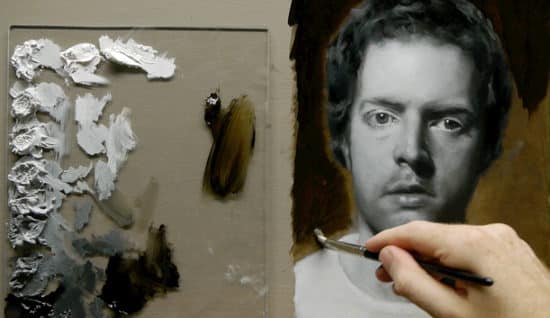
Will Kemp, video still from the course
I’ve developed a resource to help other would be portrait painters who are just starting on their journey.
‘The Essential Guide to Portraits – Mastering Black & White Portraiture with Oils’ is a downloadable video course that guides you through the process of creating a realist self-portrait in oils, using a black and white photograph as a reference.
You will learn to work confidently with a limited palette, learn Classical techniques with Oil paints and lay the foundation for all future full-colour portrait success.
If you want to understand about creating powerful portraits you need to understand about contrast and tone. Chuck Close’s favourite artist is Vermeer, another master of Chiaroscuro – the play of light & dark.
It’s not easy, but by following the step-by-step process, you can achieve some remarkable results.
I’ve taken care to film everything from my perspective so I could ensure you can see exactly what I’m doing as we go through the entire portrait process.
Click here to learn more about ‘The Essential Guide to Portraits – Mastering Black & White Portraiture with Oils’


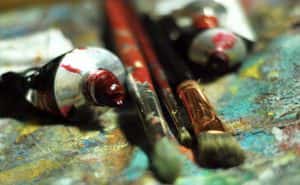

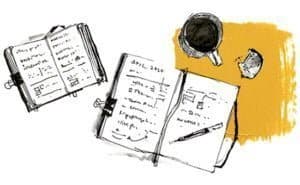
Hi Will
Thanks for this ‘mind-opener’.It helped me much. You need to strive hard for your own masterpeice even that you keep on failing.For me as a child I lack in time because of my studies but whatever comes in your way you must keep on working until you reach your goals.I will apply your tips to help me on my art skills.Thanks a lot!
Carl
Hi Carl,
Thanks for the comment, pleased to hear you enjoyed the article. It really is true, I’ve taught so many students that are so close to a breakthrough in their work but they get discouraged when the paintings don’t go to plan first time. These are all part of the creative journey and sounds like you have adopted the perfect attitude for success! But don’t forget, the most important lesson when painting is to enjoy it and have fun!
Will
Hi Will
Thanks a lot!
Carl
Excellent post. As usual!
How right you are! We always find excuses not to start painting.
And simplicity is also very important. In that sense, I think it’s great that you explain the method in a series of posts “How to Paint a Portrait in Oil”. And I’m happy I followed.
Thank you very much!
Hey Mario,
Nice to hear from you, keeping things simple can make a big difference in your paintings, thanks for the comment.
Will
Just found your Youtube channel and came here and read this article. You have a new fan. :)
Hey Colton,
Great to have you onboard. Pleased to hear you enjoyed the article,
Cheers,
Will
I completed my first ever portrait by using your portrait in oil course Will. I had never painted anything before – (except perhaps in High School and that was a very, very long time ago). With your support, the finished painting surprised the hell out of me and a number of my friends who refused to believe that this was my ‘first go’. Truly a testament to your wonderful instruction. l can’t thank you enough!
Hi Kath, thanks for the message, you’re too kind! Your painting was fantastic, really pleased you enjoyed the portrait course.
Cheers,
Will
What a great discovery! Your site popped up on a search at JUST the right moment for me. I’ve been painting, mostly in oils, for just under a year, self teaching and learning along the way but struggling to develop from the ground up rather than skipping all around.
I’ve managed to create a few satisfying pieces, but know and feel there is much more to what I can do if I could only be taught a bit.
I love Chucks advice that if you are overwhelmed by the whole, break it down into smaller pieces. Essentially, that’s how I’ve been teaching myself all along, but at some point, in order to really grow and develop, I need real instruction and guidance from a talented teacher and artist.
All the advice out there is so daunting and confusing and certainly, I’ve suffered that ‘locked-up’ feeling that has kept me sometimes from just plunging in and getting going. Until now.
I love your website and tutorials. They’re straightforward and easy to follow, but more importantly for me and probably for many others, you explain the reasonsoning and the properties of the techniques in such a way that I come away seeing HOW to do it, but also understanding WHY I should do it.
Just as your friends portrait inspired you to jump into it, so has your teaching inspired ME to get busy and ‘go for it’!
I’ll be a regular follower and look forward to your teaching programs and future communication. Today, I am getting started on a portrait Ive wanted to tackle, using your black and white tutorial as my guide. I can’t wait! Thanks SO much, Will. Thanks SO much.
Hi John,
Thanks for taking the time to comment, so pleased to hear the tutorials and articles are what you’ve been looking for! I’m a great believer in undertanding the ‘why’ as well as the ‘how’ as it always gives you a more rounded approach to your painting and drawing. Looking forward to seeing your results from the black and white portrait.
Cheers,
Will
I thought I was the only one waiting for the perfect moment to inspire me to paint. Thank you so very much for writing I needed to read this
Pleased to hear you’re feeling inspired Carey,
Cheers,
Will
Thank you Will for that article. I haven’t had a solo show since 03, life got complicated. And I fell out from the well practiced ways that I had. Anyway, I’ve been trying to reclaim my art by the balls and could relate to everything you said. I’m not procrastinating jumping into projects even if they aren’t thouroughly sketched or the most profound conceptually anymore. And it has felt great. I am breaking out of my old conceptions of what I am as an artist too. I used to work exclusively in pen and ink, but now I am trying to tackle painting which has always been intimidating for me. Thanks for reminding me to just do it.
Hey Dan, good to hear from you, and that you’re just creating, rather than over-conceptualising every idea.
Have you read The War of Art by Steven Pressfield?
It’s a quick read and is about breaking through creative blocks, but giving yourself permission just so you can create is often the best medicine!
Cheers,
Will
P.S You might also like ‘How to be creative‘ by Hugh Macleod.
Hi Will,
This is the first thing that I have read that makes sense to me on a personal growth level. I love painting portraits but I have only ever acheived anything close in pencils either graphite or coloured pencils. But I have always wanted to be able to produce large scale works of art in Oil. I have been lucky enough to vist Rome and the Vatican and was blown away by the sheer size and power of each painting. Some of my modern day painting heros are Chrtisiana Vleugels from Belguim and Robin Eley.
Oil as a medium is the only one I struggle with. It always ends up muddy and wishy washy coz i seem to always try and make the oils do what pencils do because I know how to use them, this theory is obviously flawed. I have read many online articles and watched countless tutorials in the hope that I will pick something up and nothing has given me that light bulb moment of “Ahhh now I get it” till now. So the first thing Im doing when I escape from the drudgery of a day job is to give it a go.
So massive thank you :-)
Hi Maggie,
Thanks for your comments and so pleased you’ve found the article helpful in your journey with portraiture, looking forward to hearing about your results.
Cheers,
Will
Hello Sir,
we should add something in oil paints to make oil color thin??? or direct oil color should use???
And sir what is difference between Oil paint & artist oil paint???
Hi Henna, you can use turpentine or odourless mineral spirits to dilute your oil paints, artist quality oil paints have a higher pigment load, so are just a mix of pigment and binder.
Hope this helps,
Cheers,
Will
Hi Will
Before joining up to complete your oil painting class, may I ask a few questions please?
Where to start? – Should I be practicing drawing eyes/ mouths etc in isolation first so that I understand how to draw each bit and how the light falls on them etc. Does this help or is it best to do a complete face so that the areas connect? This is my main barrier in stopping me – what’s the best way?
For a first portrait – a person with glasses – too challenging or is it easy enough to attempt?
I would like to use water mixable oil colour – does this work in the same way for your course?
Thank you
Mary
Hi Mary, I would definitely recommend drawing portraits first as even though the portrait painting course is in black and white your drawing will cause more issues than the painting.
The course doesn’t focus on the drawing of the portrait but on the oil painting technique, so if this is your first portrait I wouldn’t say it is the best suited course for you at the moment.
I would try drawing portraits to start with to build your confidence and skills, in classical ateliers students draw for up to two years before moving onto black and white paintings so don’t feel you have to try and learn everything at once.
Hope this helps,
Cheers,
Will
Thank you for giving me sensible advise Will. I love to paint but in the area of portraits I absolutely need to walk before I run! I look forward to completing one of your courses soon.
Mary
You’re welcome Mary.
Will
Sir,
in my next painting I am going to use oil & acrylic both.
Please provide suggestion/tips regarding the same.
Regards,
Hi Henna, if you keep the acrylics under the oils and have them quite diluted it will help the oils to adhere to the surface.
Cheers,
Will
Hey Will! :)
This article has helped me so much! I’ve been looking for an art class session in my surroundings for about 3 months but couldn’t find anything , so I decided to check online. :) nonetheless, I’m almost 14 years old and I love Painting! I like making portraits specifically, so this article was a lot of help. Thank you so much! :)
Great to hear it Fizza, pleased it helped with your portraits, you might find these articles of interest. on oil portrait painting.
Cheers,
Will
Hi will I would like to ask you a question if I may. . When painting or drawing a portrait , do you think that there are certain artists that will get better results drawing or painting the facial features from the inside out rather than outlining the head and features .?. The reason I ask is because I use my tablet to work from , where I get better results working from the inside out . Maybe starting with one eye then expanding on this . Most of the time this method for me works really well but when I try drawing the face as a whole the results can be very hit and miss . I always paint directly with no drawing stage as for me the directness makes it more refreshing to me . Many thanks .
Hi Dan, yes it really depends on the type of painting/drawing and finding an approach that works best for you, sometimes working with the gesture first and then adding the modelling of the features works best, other times it can be elements of the features that draws you into the portrait.
Cheers,
Will
Hi Sir,
I wanna ask what are the best type of paper used in portrait painting..
Hi John, I usually work onto a fine grain canvas or board for portrait painting, some of the tonal papers from Strathmore are really nice for portrait drawings.
Cheers,
Will
Hi will for quite some time now I have only been using two colours in my portrait mixes . They are burnt sienna and raw umber trying to keep things simple . My question is that seeing that burnt sienna is already an orange , do I need a yellow ochre .? I find yellow ochre very overpowering when used with burnt sienna . Any suggestions . ?
Hi Dan, if you’re finding it too powerful just take a little yellow ochre and premix it with the burnt sienna, then you’ll have a yellow/orange, burnt sienna and raw umber. It will work a treat.
Cheers,
Will
Thank you will
Yea I find it difficult to start …I’m always afraid of paints ,sometimes I feel I don’t have the right materials …but I will get to work now .
Hi Will, am a self taught artist in Kenya, and this is what I just needed. I have been planning to do some portraits since the begining of last year and I have done none up to date. I now have to start. Thank you.
Good one Timothy, pleased it helped.
Will
Thank you so much for this article it helped a lot ! Will be coming back to read some more!
This just changed my life. Thank you.
My pleasure Sarah, pleased you enjoyed it.
Will
Dear Will,
I’m hoping I might ask a question.
I’m working on my own subject painting and trying to incorporate your glazing techniques.
I’ve done a fairly good job with the grisaille, but I spent so much time on it it’s now become precious. You can see where I’m going. I don’t understand mixing an opaque skin tone that covers up the grisaille. It seems very counter intuitive to go over it with a colour with white in it. Is it possible to glaze with transparents to get the skin tone? Usually they are dark out of the tube until mixed with medium and then you have a lot of fat. I’m stuck with how I’m thinking. Any help for me?! Maybe you addressed this in the video but I’m not sure where. Thanks so much. Your article inspires me think I can do this if I iron out my thinking.
Hi Zumi, it is possible to glaze with transparent colours to get the skin tone, but harder to judge because you would just have to work with a much lighter original grisaille. Because oil paint becomes more transparent with time you can afford to mix in white with your mixes to lighten the colour as it will appear much more translucent over time. You can read about the refractive index of oils here: beginners guide to oil glazing.
Hope this helps,
Will
Many thanks! I will definitely look over the page. I’m very grateful you decided to teach online, I can’t even begin to tell you how much help it is.
My pleasure Zumi, that’s great to hear.
Will
Hi Will
I have used your B&W course to complete two portraits and have been thrilled with the results. I would like to try my hand at colour painting but don’t know how to start! I am happy with my drawing on a coloured ground but don’t know whether to just start slapping on the colour at this stage or if I should be covering the lines and shadows of my drawing with a thin raw umber mix, as in the B&W tutorial.
Additionally, if I was aiming to use an ‘alla prima’ technique (sorry if that is the wrong term) that might allow me to complete a painting in one sitting, what kind of medium would I start with and how many layers/stages might there be? In other words, could I use oil paint straight from the tube as my first (and possibly only) layer, or would you typically use thinner layers first then build up (ie fat over lean)? If so what is the advantage of applying multiple layers in an alla prima technique?
I sincerely hope that makes sense! I am not exaggerating when I say you have been an inspiration for me to start painting and like many people here am very grateful for what you have given us.
Thank you,
Ben
Hi Ben, nice to hear from you and so pleased you found the portrait course helpful.
I am happy with my drawing on a coloured ground but don’t know whether to just start slapping on the colour at this stage or if I should be covering the lines and shadows of my drawing with a thin raw umber mix, as in the B&W tutorial.
It depends, there are many ways to start an alla prima portrait but I will often start with an earth colour underpainting to get the basics of the drawing in and then build out the colours from there.
what kind of medium would I start with and how many layers/stages might there be? In other words, could I use oil paint straight from the tube as my first (and possibly only) layer, or would you typically use thinner layers first then build up (ie fat over lean)? If so what is the advantage of applying multiple layers in an alla prima technique?
You could use oil paint straight from the tube and create a painting in that one layer. Some of the advantages of having a thinner wash-in drawing are that you can adjust and tweak the drawing and shapes before having the complications of moving larger areas of colours around on the canvas. You can use an OMS and linseed oil medium because the painting is created in the same session the fat over lean is more forgiving.
Hope this helps,
Cheers,
Will
That’s perfect – I’ll give that a go! Thanks a lot for responding!
Ben
My pleasure Ben
Hallo Will,
Your demonstration of portrait painting has really worked for me. I used your tips to start with basic light and dark and then painted over with colour.
Previously it was very daunting because I tried to complete one section at a time, usually starting with the eyes!
Now I’m so pleased with my work because I feel much more confident that I can achieve a likeness.
Many thanks for your help. I love your videos and articles.
Syl
That’s so great to hear Syl, so glad that the methods have been helping with your portraits and you’re feeling more confident with your approach.
Cheers,
Will
This is crazy, I’m a 17 year old artist and I’m about to start a big portrait project so I was looking for some techniques and tips online, I had to leave a comment because my name is also Will Kemp (Kemp is my middle name)
Well what a coincidence Will! really hope you find the article helpful
Will